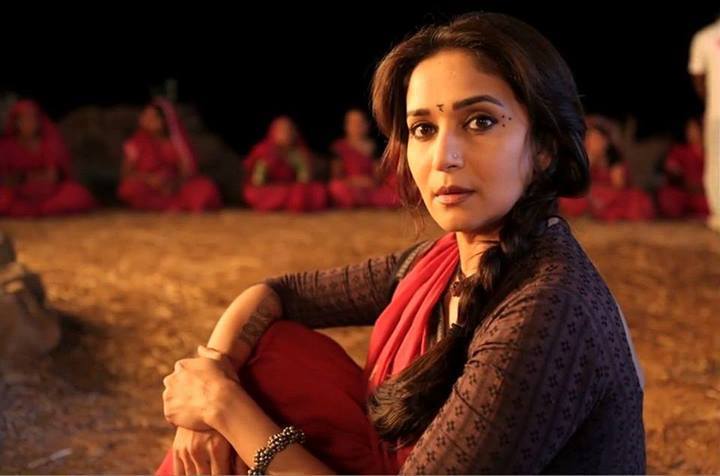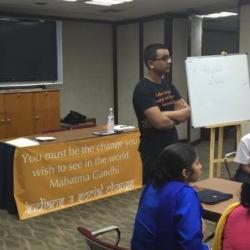Gulaab Gang: A Portrayal of Female Vigilantism in India

Gulaab Gang: The Movie
Gulaab Gang (Rose Gang), directed by Soumik Sen, is a 2014 movie that portrays a gang of women who have taken justice into their own hands. Madhuri Dixist stars as the head of the Gulaab Gang, Rajjo, whose life goal is to increase girl’s education. They wear pink saris and resort to violence when needed to get their way, including finally having their school built. Juhi Chawla stars in her first antagonist role, as Sumitra Devi, a female politician who has sold out to gain power.
Although the name and theme of the film bears striking similarity, to the real life organization, Gulaabi Gang, the director claims it is not directly a movie about their work. Days before release, the organization’s leader, Sampat Pal, moved the high court of Delhi to ban the movie. They blocked it for a while, but the movie ended up being allowed to play.
Juhi Chawla believes the movie is a great step for feminism in India, because it has two leading actresses rather than the usual duo of male and female. She told the Express Tribune:
“All the distributors and financiers said the same thing when Gulaab Gang was in its initial stages. ‘Where is Shahrukh [Khan]? Where is Aamir [Khan]? Where is the male hero? How can the film work?’ But the film does work, because the script is so powerful. Is mein dum hai (It has strength). That is what makes it unique, not the lack of a leading man.”
Gulaabi Gang: The Organization
Gulaabi Gang (Pink Gang), originally led by Sampat Pal, uses violence to stand up for women’s right. Like in the movie, the women only resort to the “lathis” (sticks) if reason doesn’t prevail. Chawla, responding to criticism that Madhuri’s portrayal shed negative light on the real Gulaabi Gang responds, “Madhuri’s Rajjo is such a righteous character. She stands for women empowerment and education. She tries dialogue first and only resorts to violence when she has no other choice. There is nothing negative about the character.”
Similarly, on the Gulaabi Gang’s website, they explain that, “The members of the gang would accost male offenders and prevail upon them to see reason. The more serious offenders were publicly shamed when they refused to listen or relent. Sometimes the women resorted to their lathis, if the men resorted to use of force.”
The organization fights against fathers, brothers, husbands, and in-laws that oppress women. They are increasingly fighting for all people who are oppressed. Their tactics go against the societal norms in place for women that encourage them to keep quiet and seek help of men, and this is largely responsible for their success.
They are located in the poorest state of India, Uttar Pradesh, and resist help from outside organizations because of the expectation of some form of return. The organization has stopped child marriages and stood up to police officers who won’t register reports on domestic violence. They work to stop female infanticide, dowries, and to empower women with education and self-defense. They use military positions to indicate rank, with Pal as Commander in Chief, adding to their threatening perception.
Although some believe that their vigilantism has no room in a democratic country, these women are tired of putting up with the oppressive structures that are built to isolate women. In their eyes, they have already used all other methods available to them, and are using violence as a last resort. For them, the courts of law have already failed, and now they must set up courts of justice to achieve what must be achieved.
Gulaabi Gang isn’t alone in their method of female empowerment. The Red Brigade takes sexual violence victims and trains them to fight. They work primarily to combat sexual harassment in their region and fight aggressive battles. They too attempt to use reason first, and violence last, but do what is needed to meet to their ends.
Gulaab Gang and Rape
In one powerful scene, a lot is conveyed about the way rape is treated by politicians in India. Rajjo goes to Sumitra to ask for help after one of her gang members is raped, and Sumitra begins a conversation with her assistant about what the “current rate” was for rape. She offers Rajjo 50,000 rupees, as if money could make up for what had happened. Meanwhile, her gang is waiting to hear from her before castrating the man who raped the girl. Upon not hearing from Rajjo, they castrate and bring him to the location of the meeting, and in a powerful moment, Rajjo looks Sumitra in the eyes and asks, “Inam ka kya rate chal raha hein? (Translation: What is the current rate for bounties?)” This embodies the attitude that women face when they attempt to achieve justice the normal way, and explains how these female vigilantes justify their use of violence.
Pink Gangs and Female Politicians
A prominent motif in the film is that of a female politician who doesn’t stand up for women’s rights. This might seem like a cynic’s perspective of Indian politics, but sadly it is very much true. Indian women who gain political power are unlikely to support women’s rights measures, because conformity with the patriarchal system is easier. Just this past January, one female politician came out and participated in victim blaming of a rape victim.
The real life Gulaabi Gang is using their methods to fight for further female participation, and ideally they can get some of their members elected, unlike the Gulaab Gang, who was unable to get the political representation they sought.
[Image Attribute: Gulaab Gang Facebook Page]




